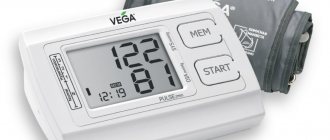A little about pressure
Blood pressure levels are expressed as two numbers, written as a fraction. The numbers mean the following: at the top is systolic pressure, which is popularly called upper, at the bottom is diastolic, or lower. Systolic is recorded when the heart contracts and pushes out blood, diastolic - when it relaxes to its maximum. The unit of measurement is millimeter of mercury. The optimal blood pressure level for adults is 120/80 mmHg. pillar Blood pressure is considered elevated if it is more than 139/89 mmHg. pillar
A condition in which its level remains consistently high is called hypertension, and a stable decrease is called hypotension. The difference between the upper and lower should be 40-50 mmHg. Blood pressure changes throughout the day for all people, but in hypertensive patients these fluctuations are much sharper.
Indicators of norms and deviations
Normal blood pressure values (units of measurement are millimeters of mercury) are individual in nature and are within the range of 120/80. The age of the patient plays a determining role in reducing or increasing the force of blood pressure. Changes within the body affect blood pressure readings, measurements of which are a mandatory diagnostic procedure that allows us to identify pathologies in the functioning of the heart muscle and vascular system. Indications of normal and pathological blood pressure values, reflecting the state of blood vessels and the work of the heart muscle, can be seen in the table:
| № | CATEGORY HELL | NORMAL SYSTOLIC PRESSURE, mmHg. | NORMAL DIASTOLIC PRESSURE, MM Hg. |
| 1. | Optimal blood pressure value | ||
| 2. | Normal blood pressure | 120-129 | 80-84 |
| 3. | High normal blood pressure | 130 — 139 | 85-89 |
| 4. | Hypertension of the first degree of severity (mild) | 140-159 | 90-99 |
| 5. | Hypertension II degree of severity (moderate) | 160-179 | 100-109 |
| 6. | Hypertension III degree of severity (severe) | ≥180 | ≥110 |
| 7. | Isolated systolic hypertension | ≤140 | ≤90 |
Deviations from such norms in an increasing or decreasing direction indicate the need to identify the causes of the pathological state of the heart muscle and vascular system and determine ways to eliminate them.
Why do you need to know your blood pressure?
Even a slight increase in blood pressure increases the risk of heart attack, stroke, ischemia, heart and kidney failure. And the higher it is, the greater the risk. Very often, hypertension in the initial stage occurs without symptoms, and a person is not even aware of his condition.
Measuring blood pressure is the first thing to do if you complain of frequent headaches, dizziness, or weakness.
Hypertensive patients should measure their blood pressure every day and monitor its level after taking the pills. People with high blood pressure should not sharply reduce it with medications.
Features of measuring pressure with a mechanical tonometer
Each person could see how to do it correctly when undergoing a medical examination.
The procedure is quite simple and takes no more than 5 minutes. The obtained indicators are influenced by the patient’s age, weather, the presence of pathologies and body position, therefore small deviations from the norm within 10-15 units are allowed. It is quite simple to understand how to measure your own blood pressure using a mechanical tonometer if you familiarize yourself with the following algorithm of actions:
- Sit comfortably on a chair, straightening your legs, leaning completely against its back and placing your hand on the table, bending it at the elbow. The limb should remain at chest level to obtain the most accurate readings. It is first necessary to free her from clothing so as not to further compress the artery.
- Place the cuff just above the elbow (around the forearm). It is important that there is no air in it. Otherwise, the obtained values may differ slightly from the true indicators. The cuff should be tightened, but not too tight. If it hangs freely on your arm, then low pressure will be recorded. Otherwise, the indicators will be overestimated and the person will experience discomfort during the procedure due to pinching of the limb. You can tell that the cuff is on correctly by inserting 2 fingers under it. If the manipulation is difficult, but realistic, then everything is correct.
- Find the brachial artery slightly above the elbow and apply a sound membrane to it. It is not advisable to hold it with your thumb. It will reflect its own pulse, which will interfere with listening to tones. Experts advise fixing the stethoscope head with your index or middle finger. It is equally important to place it slightly below the edge of the cuff so that additional noise is not created.
- After checking that the cuff is securely fastened and leaning the sound membrane to the desired place, take the pear with the other hand. Close the valve firmly (clockwise) so that air does not escape during the pumping process.
- Start pressing hard on the pear. The cuff will inflate, thereby compressing the artery. Continue the process until the readings on the pressure gauge screen are 160-180 mmHg. Art. Then open the valve on the bulb slightly so that air begins to escape from the cuff. Its speed should not exceed 1-2 units to successfully record values.
- While releasing air, try to hear the first tone. It is the upper (systolic) threshold, which shows the force of blood pressure on the vessels at the moment of cardiac contraction.
- Gradually the noise will increase. Having reached its maximum, it will begin to subside. The last tone heard is the lower (diastolic) threshold. It shows the force of blood pressure during complete relaxation of the heart muscle.
- Indicators equal to 120/80 (+-10-15 units) are acceptable. If the pressure is higher or lower than normal, then after 3 minutes you will have to measure again. If a negative result is confirmed, it is recommended to consult a doctor.
Having figured out how to measure blood pressure without leaving home, you can protect yourself from the development of hypertension or hypotension by periodically using a tonometer. To obtain more accurate data, it is advisable to remember the following tips:
- When measuring the blood pressure of a large person, problems often arise with the size of the cuff. The forearm may be too large. In this case, you will have to purchase a device specifically for the individual characteristics of the structure or go to the hospital for measurements. For kids, the situation is exactly the opposite. Their hand is too small, so they will have to buy a child cuff.
- When performing the procedure on yourself or another person, you must remain silent and turn off third-party devices that make sounds in order to hear the tone.
- Before repeating the measurement, at least 3 minutes must pass. The hand was pinched, so it takes time for it to return to normal. Otherwise, the indicators will be overestimated.
- For convenience, the pressure gauge can be hung on clothing when taking measurements for another person or placed on the table in front of your eyes.
Methods for measuring blood pressure
Blood pressure levels can be determined directly and indirectly.
Straight
You can also read: Increased blood pressure
This invasive method is highly accurate, but it is traumatic because it involves directly inserting a needle into a vessel or cavity of the heart. The needle is connected to the pressure gauge by a tube containing an anti-clotting agent. The result is a curve of blood pressure fluctuations recorded by a scribe. This method is most often used in cardiac surgery.
Indirect methods
Typically, pressure is measured in the peripheral vessels of the upper extremities, namely in the elbow bend of the arm.
Nowadays, two non-invasive methods are widely used: auscultatory and oscillometric.
The first (auscultatory), proposed by the Russian surgeon N. S. Korotkov at the beginning of the 20th century, is based on clamping the shoulder artery with a cuff and listening to the tones that appear when air is slowly released from the cuff. Upper and lower pressure are determined by the appearance and disappearance of sounds that are characteristic of turbulent blood flow. Blood pressure measurement using this method is carried out using a very simple device consisting of a pressure gauge, a phonendoscope and a cuff with a pear-shaped balloon.
When measuring blood pressure in this way, a cuff is placed on the shoulder area, into which air is pumped until the pressure in it exceeds systolic pressure. At this moment, the artery is completely pinched, the blood flow in it stops, and no sounds are heard. As the cuff begins to deflate, the pressure decreases. When the external pressure is compared with the systolic pressure, blood begins to pass through the compressed area, noises appear that accompany the turbulent flow of blood. These are called Korotkoff sounds and can be heard with a phonendoscope. At the moment when they occur, the value on the pressure gauge is equal to systolic blood pressure. When the external pressure is compared with the arterial pressure, the sounds disappear, and at this moment the diastolic pressure is determined using the manometer.
To measure Korotkoff blood pressure, a mechanical tonometer is used.
The microphone of the measuring device picks up Korotkoff sounds and converts them into electrical signals, which are sent to a recording device, on the display of which the values of the upper and lower blood pressure appear. There are other devices in which the arising and disappearing characteristic noises are determined using ultrasound.
The Korotkoff blood pressure measurement method is officially considered a standard. It has both pros and cons. Among the advantages include high resistance to hand movement. There are several more disadvantages:
- Sensitive to noise in the room where measurements are taken.
- The accuracy of the result depends on whether the head of the phonendoscope is correctly positioned and on the individual qualities of the person measuring blood pressure (hearing, vision, hands).
- Skin contact with the cuff and microphone head is required.
- It is technically complex, which causes errors in measurements.
- This requires special preparation.
Oscillometric With this method, blood pressure is measured with an electronic tonometer. The principle of this method is that the device registers pulsations in the cuff, which appear when blood passes through a compressed area of the vessel. The main disadvantage of this method is that the hand must be motionless when measuring. There are quite a lot of advantages:
- No special training is required.
- The individual qualities of the person measuring (vision, hands, hearing) do not matter.
- Resistant to noise present in the room.
- Determines blood pressure with weak Korotkoff sounds.
- The cuff can be worn over a thin jacket, and this does not affect the accuracy of the result.
How is blood pressure measured?
If a person is faced with determining his blood pressure for the first time, he may not know how to use the automatic device, and what the mysterious letters “mm Hg” mean. st." Meanwhile, these are millimeters of mercury in which blood pressure is measured. The device was invented several decades ago, but it is still relevant today. The device operates very simply. Under the influence of the force of blood pressure, the mercury column in it releases or rises, showing the unit of pressure in millimeters.
Types of tonometers
Today, aneroid (or mechanical) devices and electronic ones are used to determine blood pressure.
The former are used to measure pressure using the Korotkoff method in a medical facility, since they are too complex for home use, and untrained users receive results with errors when taking measurements.
An electronic device can be automatic or semi-automatic. Such tonometers are intended for daily home use.
Anyone can use an electronic tonometer to measure their own blood pressure and pulse.
Basic information
The definition of “arterial (blood) pressure”, or “BP”, refers to the force with which blood presses on the walls of large blood vessels. The physiology of this phenomenon is based on the work of the heart - providing blood circulation in the systemic circle, it performs contractile movements. The moment of tension of the heart muscle is called systole, and relaxation is called diastole, and when the myocardium contracts and relaxes, the blood presses on the vascular walls with different forces.
Laboratory methods for determining pressure indicators are divided into two groups - invasive and non-invasive. The first ones are not applicable in an outpatient setting; they are carried out in a hospital. The technique involves measuring parameters directly in the bloodstream by inserting needles connected to devices into the arteries. Palpation, oscillometric and auscultatory methods are used as non-invasive methods, which allow you to measure blood pressure without blood:
- Oscillometric. It is based on the use of electronics - automatic tonometers that record air pressure and pulsation that occurs when blood passes through a compressed section of the artery. The advantage is that it is easy to use and can be used at home. The accuracy leaves much to be desired, so doctors practice it in rare cases.
- Auscultatory. The second name of the method is blood pressure measurement according to Riva-Rocci and Korotkov. The procedure involves the use of a phonendoscope and a hand-held tonometer equipped with a bulb and a special scale with divisions.
- Palpation. Manipulations are carried out manually without the use of a stethoscope - the arteries are compressed using a cuff, and the pulse is felt below its edge. When it disappears, the diastolic pressure is recorded, and when it appears, the systolic pressure is recorded. The palpation method is not considered informative, since it is extremely difficult to accurately determine the pulse without special devices.
Blood pressure (BP) is one of the most important markers characterizing the functioning of the cardiovascular system. Blood pressure indicators are not static and can change both depending on external conditions and as a result of many diseases of internal organs. Healthy people have a relatively stable blood pressure level, but with physical and nervous overload, poor diet, and negative effects of atmospheric phenomena, the pressure values fluctuate slightly.
When measuring blood pressure, two main indicators are taken into account:
- Systolic (top number) is the level of pressure when the heart compresses and pushes blood into the arteries. This value depends on the strength of cardiac contraction and the number of such contractions in a certain time unit.
- Diastolic (lower value) is a number that shows the blood pressure in the arteries when the heart muscle relaxes.
Blood pressure norms are individual in nature and primarily depend on the person’s age. The average number is within 120/80 (systolic/diastolic) millimeters of mercury. The difference between systolic and diastolic readings is called pulse pressure, which normally should be about 35-55 mmHg. Art.
Arterial hypertension is a sustained increase in blood pressure, in which the latter is above 140/90 mm Hg. Art. In 90−95% of cases, patients are diagnosed with chronic hypertension (or essential hypertension), and in the remaining 5% of patients, the pressure exceeds the norm due to endocrine, renal, neurological, and hemodynamic disorders.
We suggest you read: Hormones that increase blood pressure
Hypertension is one of the most common pathologies. According to statistics, it affects more than 20−30% of middle-aged people and 55−65% of people over 60−65 years of age. Depending on the degree and nature of the disease, there are several main stages:
- initial (blood pressure readings more than 140−159/91−99 mmHg);
- average (160−179/100−109 mmHg);
- severe (more than 180/above 110 mm Hg).
An excessive increase in blood pressure can cause a hypertensive crisis, in which there are serious disturbances in the blood supply to the heart and brain. Most often this manifests itself with the following symptoms:
- chest pain and shortness of breath;
- rapid fatigue and loss of performance;
- fear, anxiety, nervousness and insomnia;
- congestion and tinnitus;
- pain in the back of the head;
- poor concentration and dizziness;
- redness of the skin of the face and chest.
A noticeable decrease in normal blood pressure (below 90/60 mmHg) is called arterial hypotension. There are two types of this pathology: chronic and acute. The chronic form can have completely different causes, but is generally characterized by mild symptoms associated with a general dysregulation of blood pressure.
The acute stage of arterial hypotension (a sharp drop in pressure) is accompanied by severe hypoxia of brain tissue, which may indicate acute myocardial infarction, severe arrhythmia, severe blood loss, pulmonary embolism, intracardiac block, allergic reaction, etc.
Symptoms of pathology:
- frequent fainting;
- dizziness;
- lethargy, drowsiness, apathy;
- weather dependence;
- irritability and emotional instability;
- dull or throbbing pain in the frontoparietal or temporal region;
- nausea and tendency to motion sickness;
- violation of thermoregulation (cold upper and lower extremities);
- absent-mindedness and loss of strength;
- rapid heartbeat and shortness of breath;
- pallor of the skin.
General rules for measuring blood pressure
Blood pressure is most often measured while sitting, but is sometimes done while standing or lying down.
People's daily blood pressure is constantly changing. It increases with emotional and physical stress. It can be measured not only in a calm state, but also during physical activity, as well as in breaks between different types of loads.
Since blood pressure depends on a person's condition, it is important to provide the patient with a comfortable environment. The patient himself needs to not eat, not engage in physical labor, not smoke, not drink alcoholic beverages, and not be exposed to cold for half an hour before the procedure.
During the procedure, you should not make sudden movements or talk.
It is recommended to take measurements more than once. If a series of measurements is made, between each approach you need a break of about one minute (at least 15 seconds) and a change of position. During the break, it is recommended to loosen the cuff.
The pressure on different hands can vary significantly; therefore, measurements are best taken on the one where the level is usually higher.
There are patients whose blood pressure is always higher in the clinic than when measured at home. This is explained by the excitement that many feel when they see medical workers in white coats. For some, this can happen at home as well, as a reaction to measurement. In such cases, it is recommended to take measurements three times and calculate the average value.
How to measure blood pressure correctly
Measurements are usually taken on the left hand, but this is the case if the person is right-handed. Therefore, in order to obtain the most accurate results, this factor must always be taken into account.
The most difficult way to measure blood pressure is with a manual tonometer. Working with such a device requires some skills. But this device is more practical and reliable, since its operation does not depend on battery charge.
A mechanical tonometer consists of a bulb, which is attached to a cuff using a rubber tube. The same element is attached to the monometer. Also included is a phonendoscope, with which you can listen to the sound manifestation of the indicators.
Pressure measurement process:
- The cuff must be placed on the forearm. The area should be selected so that it is two to three centimeters higher from the elbow.
- The cuff should fit tightly around the arm and be secured with Velcro.
- The hearing part of the stethoscope is inserted into the ears, and the membrane amplifier is applied to the inside of the limb, in the area where the pulsating artery is located.
- Next, you should check that the meter needle is at zero. If this is not the case, it means that there is air in the cuff (you need to deflate it all the way) or the determiner is broken (in this case it will not be possible to measure correctly).
- After this, you need to tighten the valve on the bulb, thereby preventing air from escaping during injection.
- Then you need to inflate the cuff by repeatedly squeezing and unclenching the bulb. This must be done until the arrow on the monometer becomes higher than the expected number. It is recommended to choose this indicator based on previous measurements.
- After this, the air pumping must be stopped and the valve on the bulb must be slowly unscrewed.
- The arrow on the screen will gradually move down. She should be monitored closely.
- The first knock that appears in the auditory part of the phonendoscope is an indicator of upper pressure.
- A clear tone will be heard for a while. Then it will begin to subside. The moment when the sound disappears completely and is indicated by the number of the lower, that is, diastolic blood pressure.
- The air from the cuff must be completely deflated and you can remove it from your hand.
It is much more convenient to take measurements using automatic and semi-automatic partings. They don't require much practice.
Anyone can handle such devices. You can choose an electrical device for the forearm and hand.
An automatic tonometer is a device consisting of a cuff and a display. It also needs to be put on the hand, but that’s where all human participation ends. He himself pumps the air to the required levels and releases it himself. The final results are displayed on the screen. The disadvantage of this device is that it can only measure if it has batteries. And if the batteries do not have sufficient charge, errors in the indicators are possible. If you decide to choose such a device, you will need to regularly monitor the condition of the charging elements.
The operating principle of a semi-automatic tonometer is partly similar to an automatic device. It also records the numerical results of systolic and diastolic blood pressure without assistance, but cannot pump air on its own. To do this, there is a bulb through which you need to pump it into the cuff with your own hands. Further, the electrical mechanism itself records the numerical indicators at which the artery straightens (based on changes in air pressure in the cuff).
It is preferable to measure blood pressure at home. This is due to the fact that in a familiar environment a person is more relaxed and does not experience the stress that can be observed in a hospital.
Author of the article: Kristina Borisova
The procedure for determining blood pressure in different categories of patients
In the elderly
This category of people often experiences unstable blood pressure, which is associated with disturbances in the blood flow regulation system, decreased vascular elasticity, and atherosclerosis. Therefore, elderly patients need to take a series of measurements and calculate the average value.
In addition, they need to measure their blood pressure while standing and sitting, since they often experience a sharp drop in blood pressure when changing positions, for example, when getting out of bed and sitting.
In children
It is recommended that children measure blood pressure with a mechanical tonometer or an electronic semi-automatic device, and use a children's cuff. Before measuring your child’s blood pressure yourself, you need to consult with your pediatrician about the amount of air pumped into the cuff and the measurement time.
In pregnant women
Blood pressure can tell you how well your pregnancy is going. For expectant mothers, it is very important to constantly monitor blood pressure in order to start treatment on time and avoid serious complications in the fetus.
During pregnancy, blood pressure monitoring is mandatory
Pregnant women need to measure their blood pressure while reclining. If its level exceeds the norm or, conversely, is much lower, you should immediately consult your doctor.
For cardiac arrhythmia
People who have irregular heartbeat sequence, rhythm and frequency should measure their blood pressure several times in a row, discard clearly incorrect results and calculate the average value. In this case, the air from the cuff must be released at a lower speed. The fact is that with cardiac arrhythmia, its level can vary significantly from beat to beat.
Instructions for measuring blood pressure
Step-by-step instructions for taking measurements of an important indicator that reflects the condition of blood vessels and the patient’s health in general involve several simple steps. . Place the tonometer cuff on the shoulder area and place your hand on a hard surface so that the level of the heart and the center of the air filling chamber are on the same horizontal line. Press the button on an automatic oscillographic blood pressure measurement device or provide compression in the shoulder area by pumping air into the cuff chamber using a pear-shaped balloon that comes with semi-automatic blood pressure monitors. Wait for an audible signal indicating that external pressure is sufficient to compress the artery. Provide air deflation on a semi-automatic tonometer or wait for automatic decompression. Record the readings that appear on the device display. Measuring blood pressure on the second arm. Calculate the average value of the results obtained.
- Place the tonometer cuff on the shoulder area and place your hand on a hard surface so that the level of the heart and the center of the air filling chamber are on the same horizontal line.
- Press the button on an automatic oscillographic blood pressure measurement device or provide compression in the shoulder area by pumping air into the cuff chamber using a pear-shaped balloon that comes with semi-automatic blood pressure monitors.
- Wait for an audible signal indicating that the external pressure is sufficient to compress the artery.
- Provide air deflation on a semi-automatic tonometer or wait for automatic decompression.
- Record the readings that appear on the device display.
- Measuring blood pressure on the second arm.
- Calculate the average value of the results obtained.
It is recommended to measure blood pressure in the morning and evening. Knowing how to determine blood pressure readings, you can always avoid the development of complications associated with the lack of timely treatment of a dangerous disease.
Blood pressure measurement algorithm
Blood pressure measurements should be taken in the following order:
- The patient is seated comfortably on a chair so that his back is adjacent to the back, that is, has support.
- The hand is freed from clothing and placed on the table with the palm up, placing a roll of a towel or the patient’s fist under the elbow.
- A blood pressure cuff is placed on the bare shoulder (two to three centimeters above the elbow, approximately at heart level). Two fingers should fit between the hand and the cuff, its tubes pointing down.
- The tonometer is at eye level, its needle is at the zero mark.
- Find the pulse in the ulnar fossa and apply a phonendoscope to this place with slight pressure.
- The valve on the tonometer bulb is screwed on.
- The pear-shaped balloon is compressed and air is pumped into the cuff until pulsation in the artery can no longer be heard. This occurs when the pressure in the cuff exceeds 20-30 mmHg. pillar
- Open the valve and release air from the cuff at a speed of about 3 mmHg. pillar, while listening to Korotkoff sounds.
- When the first constant tones appear, record the pressure gauge readings - this is the upper pressure.
- Continue to release air. As soon as the weakening Korotkoff sounds disappear, the pressure gauge readings are recorded - this is the lower pressure.
- Release air from the cuff, listening to sounds, until the pressure in it becomes equal to 0.
- Allow the patient to rest for about two minutes and measure blood pressure again.
- Then remove the cuff and record the results in a diary.
Correct position of the patient during blood pressure measurement
Rules for measuring blood pressure in the legs
On the legs they start measuring pressure much less often. First of all, because it is inconvenient, but it is necessary to clarify the diagnosis of certain vascular diseases of the lower extremities.
The lower extremities are further from the heart, and blood pressure readings are different in the arms and legs. The range of such deviations is wide; only an experienced doctor can understand them. Ideally, if the readings match. Deviations of 20 mmHg are permissible. Art., on different legs up to 5 mm Hg. Art.
Sequencing
There are two ways to measure pressure - at the ankle and at the thigh.
- Measurement at ankle. The patient lies on his back, legs should be extended and at the same level as the heart. 5-10 minutes after the patient has rested and calmed down, a tonometer cuff is placed on the ankle above the dorsum of the foot by 2-3 cm, the pulse is monitored at the tibial artery, which is located on the inside of the ankle.
- Measurement at the hip. It differs from the first study in that the patient lies on his stomach and the cuff should be larger. It is fixed on the thigh 2-3 cm above the knee bend. The pulse is controlled through the artery in the popliteal fossa.
The research mechanism itself is no different from measuring blood pressure in the arms.
Wrist blood pressure measurement technique
To measure blood pressure at the wrist with an electronic device with a cuff, you must follow the following instructions:
- Remove watches or bracelets from your wrist, unbutton the sleeve and fold it back.
- Place the tonometer cuff 1 centimeter above the hand with the display facing up.
- Place the hand with the cuff on the opposite shoulder, palm down.
- With your other hand, press the “Start” button and place it under the elbow of your cuffed arm.
- Remain in this position until the air is automatically released from the cuff.
This method is not suitable for everyone. It is not recommended for people with diabetes, atherosclerosis and other blood supply disorders and changes in the vascular walls. Before using such a device, you need to measure the pressure with a tonometer with a cuff on the shoulder, then with a cuff on the wrist, compare the obtained values and make sure that the difference is small.
A wrist blood pressure monitor has both advantages and disadvantages.
Algorithm and technique for measuring pressure
For home use, you can purchase a mechanical or electronic semi-automatic or automatic meter
When choosing a tonometer, you need to pay attention to the type of cuff: size, shape, fixation on the wrist, shoulder. In addition, it is worth assessing the advantages and disadvantages of using a specific tonometer model if you have problems with hearing, vision or the musculoskeletal system (arthrosis of the hands and other pathologies)
The task is to properly prepare a person to analyze the pressure level and become familiar with the technique of performing the procedure. The preventative device itself must be periodically inspected by a technician; usually there is such an employee in places where medical equipment is sold. The goal is to identify possible malfunctions in the operation of the tonometer, leading to distortion of the readings.
What to consider when measuring pressure
- Stress can significantly change the readings, so you need to measure it in a calm state.
- Blood pressure increases with constipation, immediately after eating, after smoking and drinking alcohol, with excitement, and in a sleepy state.
- It is best to carry out the procedure one to two hours after eating.
- Blood pressure should be measured immediately after urination, since it is elevated before urination.
- The pressure changes when taking a shower or bath.
- A nearby mobile phone can change the tonometer readings.
- Tea and coffee can change blood pressure.
- To stabilize it, you need to take five deep breaths.
- It increases when you are in a cold room.
A few words about pressure. Why do you need to measure it?
The pressure in the vessels can be called: arterial, cardiac, blood. It represents the force of the blood flow on the walls of the blood arteries. It has 2 indicators:
- systolic, which is also called upper;
- diastolic (lower).
The force of the blood flow on the walls of blood vessels during systole - the contraction of the ventricles and the pushing of blood flow by the left ventricle into the aorta - is an indicator of systolic pressure. The lower indicator indicates strength in the final stage, with complete relaxation of the muscle tissue of the heart.
We can say that the norm of pressure is a somewhat abstract concept, since it is individual for each person. This depends on physiological characteristics, age, and lifestyle (physical activity, etc.). There is no single figure for everyone, but in medicine there is an average indicator that is considered the standard - 120/80 mmHg.
Here is a table of average indicators for the adult population. Let us immediately note that deviations up or down from the figures indicated above by 20 mmHg. acceptable and not considered pathological. As for the child population, the blood pressure figures differ significantly. The table shows the average indicators for children.
Controlling your arterial (blood) pressure is necessary. For what?
- Firstly, deviations from the norm can provoke:
- infarction (necrosis of part of the myocardium);
- ischemia;
- failure (heart, kidney);
- stroke (acute circulatory disorder in the brain).
The higher the reading on the tonometer, the more serious the risk of developing the above pathologies. Controlling your pressure will help minimize their development.
- Secondly, deviations to a lesser extent from the norms are fraught with:
- impaired peripheral circulation;
- cardiogenic shock;
- stroke;
- cardiac arrest (clinical death).
People at particular risk are those suffering from:
- hypertension – chronically stable high blood pressure. In the first stages it has no symptoms, so people are not aware of its presence and because of this they end up in the hospital, where they are diagnosed with hypertension, already in serious condition;
- hypotension - consistently low blood pressure, is less common than hypertension and can be a physical norm, or may indicate impaired hemodynamics in the body.










